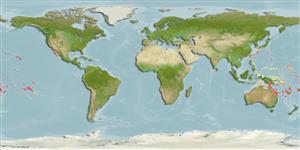>
Blenniiformes (Blennies) >
Blenniidae (Combtooth blennies) > Blenniinae
Etymology: Enchelyurus: Greek, enchelys, = eel + Greek, oura = tail (Ref. 45335).
More on author: Günther.
Environment: milieu / climate zone / depth range / distribution range
Ökologie
seewasser riff-verbunden; tiefenbereich 1 - 10 m (Ref. 86942). Tropical
Pacific Ocean: Coral Sea (excluding the Great Barrier Reef) to the Tuamoto Islands.
Size / Gewicht / Alter
Maturity: Lm ? range ? - ? cm
Max length : 5.5 cm TL Männchen/unbestimmt; (Ref. 2334)
Rückenflossenstacheln (insgesamt) : 8 - 10; Rückenflossenweichstrahlen (insgesamt) : 20 - 24; Afterflossenstacheln: 2; Afterflossenweichstrahlen: 18 - 21. Fewer than 50 incisiform teeth in each jaw; large canine on sides of both upper and lower jaw; absence of head cirri; dorsal fin unnotched; dorsal and anal fins fully confluent with caudal fin; coloration dark brown to black, occasionally with faint reticular or barred pattern; numerous small, uneven brown spots on head; yellow paired fins. Dorsal rays modally 2; anal rays modally II, 19; pelvic spine hidden; segmented caudal rays 14, unbranched (Ref. 54980).
Oviparous. Eggs are demersal and adhesive (Ref. 205), and are attached to the substrate via a filamentous, adhesive pad or pedestal (Ref. 94114). Larvae are planktonic, often found in shallow, coastal waters (Ref. 94114).
Life cycle and mating behavior
Geschlechtsreife | Fortpflanzung | Ablaichen | Eier | Fecundity | Larven
Oviparous, distinct pairing (Ref. 205).
Randall, J.E., G.R. Allen and R.C. Steene, 1990. Fishes of the Great Barrier Reef and Coral Sea. University of Hawaii Press, Honolulu, Hawaii. 506 p. (Ref. 2334)
IUCN Rote Liste Status (Ref. 130435: Version 2024-1)
Bedrohung für Menschen
Harmless
Nutzung durch Menschen
Tools
Zusatzinformationen
Download XML
Internet Quellen
Estimates based on models
Preferred temperature (Ref.
123201): 24.2 - 29, mean 26.9 °C (based on 601 cells).
Phylogenetic diversity index (Ref.
82804): PD
50 = 0.5312 [Uniqueness, from 0.5 = low to 2.0 = high].
Bayesian length-weight: a=0.00575 (0.00253 - 0.01308), b=3.06 (2.86 - 3.26), in cm total length, based on LWR estimates for this (Sub)family-body shape (Ref.
93245).
Trophic level (Ref.
69278): 3.3 ±0.4 se; based on size and trophs of closest relatives
Widerstandsfähigkeit (Ref.
120179): hoch, Verdopplung der Population dauert weniger als 15 Monate. (Preliminary K or Fecundity.).
Fishing Vulnerability (Ref.
59153): Low vulnerability (10 of 100).
Nutrients (Ref.
124155): Calcium = 247 [122, 443] mg/100g; Iron = 1.06 [0.60, 1.86] mg/100g; Protein = 18.2 [16.9, 19.2] %; Omega3 = 0.096 [0.050, 0.184] g/100g; Selenium = 21.5 [9.3, 49.6] μg/100g; VitaminA = 134 [39, 452] μg/100g; Zinc = 2.85 [1.83, 4.22] mg/100g (wet weight);
